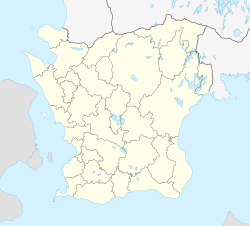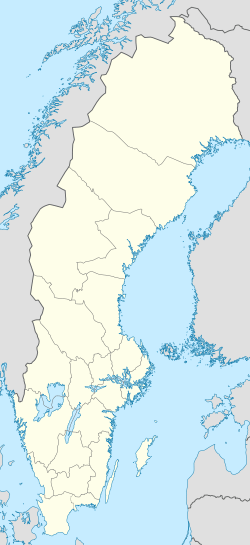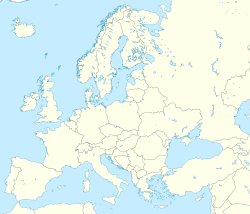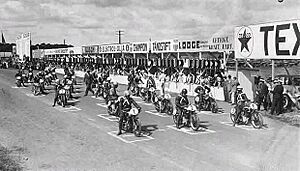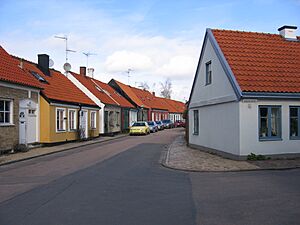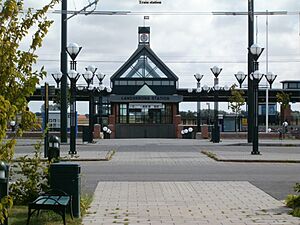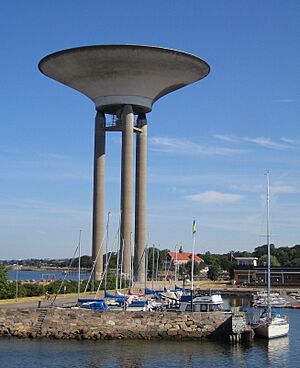Landskrona facts for kids
Quick facts for kids
Landskrona
|
||
|---|---|---|
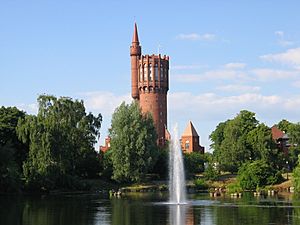
The old water tower viewed across St. Olof's lake
|
||
|
||
| Country | Sweden | |
| Province | Scania | |
| County | Scania County | |
| Municipality | Landskrona Municipality | |
| Charter | 15th century | |
| Area | ||
| • Total | 12.95 km2 (5.00 sq mi) | |
| Population
(31 December 2020)
|
||
| • Total | 33,372 | |
| • Density | 2,572/km2 (6,660/sq mi) | |
| Time zone | UTC+1 (CET) | |
| • Summer (DST) | UTC+2 (CEST) | |
Landskrona is a town in Scania, Sweden. It is located by the sea called Öresund. The town has a natural harbor, which has always been important for trade and defense.
Ferries travel from Landskrona to the island of Ven. For many years, there was also a ferry connection to Copenhagen. Landskrona is part of the Øresund region, which connects Sweden and Denmark. It is the main town of Landskrona Municipality.
Contents
Discovering Landskrona's Past
Landskrona was officially founded in 1413 by Eric of Pomerania, who was the King of Denmark. He wanted it to be a trading city that could compete with other towns controlled by the Hanseatic League. However, some old records show the town was mentioned as "Landzcrone" as early as 1405.
The area where Landskrona was built has one of the few natural harbors in Scania. At that time, Scania was part of Denmark. Before the town was founded, there was a small fishing village called Sønder Sæby here. The original name of the town was Landszcrone, which later changed to Landskrone before 1450.
A Carmelite monastery was built in 1410. English merchants were given special trading rights in 1412. The town itself received its official charter in 1413. The monastery was later closed by King Christian III after the reformation. However, its memory lives on in the street name "Karmelitergatan".
Building the Citadel
Construction of Landskrona Citadel began in the 1540s. King Christian III ordered its building. The castle was finished in 1559. It was a strong fortress with thick walls and a moat (a deep ditch filled with water). Over the centuries, a huge system of moats was built around the castle. Parts of four of these moats still exist today.
The town supported King Christian II in 1525. It also opposed the Reformation in Denmark in 1535. In both cases, Landskrona ended up on the losing side. However, King Christian III chose not to punish the town. Instead, he built the castle to protect the harbor. The castle was built where the monastery used to be.
After Scania became part of Sweden in 1658, Landskrona's good harbor and strong fort made it a target for new plans. The Swedes wanted to make it a major trading center. The castle was made even stronger with bastions. The area inside the moats was expanded to be very large.
The castle was thought to be the strongest and most modern in Scandinavia. But it was briefly lost to the Danes in 1676 after a short siege. The commander, Colonel Hieronymus Lindeberg, was later sentenced to death for treason.
Changes to the Town
In 1753, the Swedish military worried that the tower of Sancti Johannis Baptistae church could be a threat to the citadel. So, they demanded the church be torn down. A new church, Sofia Albertina Church, began construction the next year. It was finally finished in 1812. This new church has two towers, which is unusual for a church that is not a main church for a region.
Landskrona's military importance decreased after the 18th century. Wars between Sweden and Denmark led to Karlskrona becoming the main naval base instead. Karlskrona was safer because it was further from Denmark. Even though Landskrona's defenses were greatly expanded between 1747 and 1788, they were declared old-fashioned in 1822. The military base was closed in 1869.
Today, the walls and moats of Landskrona Citadel are a fun area for people to visit. The castle also has a museum. On the northern side, there is an area with small garden cottages. This is the oldest area of its kind in Sweden. The military's old exercise field is now a public park called "Exercisfältet" or "Exan".
Growth and Industry
The town grew quickly after the Industrial Revolution. Many people moved from the countryside to live and work in the town. During the First World War, a large shipyard called Öresundsvarvet was built. In the mid-1970s, this shipyard employed over 3,500 people. This was a huge number for a town with only 30,000 residents. The shipyard closed down in stages from the late 1970s, finally closing in 1983.
On May 14, 1919, a Swedish engineer and flight pioneer named Enoch Thulin died in Landskrona. He crashed his own airplane. His funeral was held in Sofia Albertina Church.
Between 1930 and 1939, the Saxtorp TT-races were held just south of the town. These motorcycle races attracted huge crowds, sometimes up to 160,000 people. They are considered the largest sporting events ever held in Sweden by crowd size.
Landskrona's Geography
Town Buildings and Design
The center of Landskrona and buildings along the main roads usually have two to seven floors. Because it was a fortified town, stone houses were preferred over wooden ones. So, you won't see many traditional Danish or Scanian half-timbered houses here.
Besides the Citadel and Sofia Albertina Church, other important old buildings include the Town Hall (Rådhuset), the Landskrona museum, the old railway station, and the theater.
Many of the town's central areas were designed by former town architects. Fredrik Sundbärg worked from 1901 to 1913, and Frans Ekelund from 1913 to 1949. Sundberg designed important buildings like the old water tower, the Tuppaskolan school, and the power station. Ekelund believed in the Garden city movement. He set aside areas for people to build their own smaller homes with cellars and two floors.
Around 1970, architect Ralph Erskine designed the row house area called Esperanza, which means 'hope' in Spanish. The new water tower also started working that same year.
An old water tower in town was built in 1904. It is 65.9 meters tall. The water tower stopped being used in 1975. In 1992, parts of the building were turned into apartments.
The Harbor Area
A natural deep harbor has been here even before the town was founded. It is mentioned in a Danish history book from around 1200. The port is naturally deep because of a special feature in the sandy seabed. Since the 18th century, the harbor has been protected by an artificial island called Gråen.
In the 1960s, the harbor had about 3 kilometers of quay (where ships dock). As of 2017, the usable quay length is much shorter, around 1250 meters. The harbor's activity has been low for many years.
The former car ferries to Copenhagen-Tuborg left from the Nyhamn port in the northern part of the harbor. The waters just south of the harbor are very shallow. During cold winters, Sea ice can form here much faster than in most other parts of Øresund.
Travel Across the Øresund
For many years, Landskrona had car ferries and other ships going to and from Copenhagen. From 1951 to 1980, SL ferries operated between Port of Tuborg in northern Copenhagen and Landskrona. Smaller passenger ships also traveled between the Inner Harbour of Copenhagen and Landskrona.
In 1985, Scarlett Line started sailing to Port of Tuborg again. In 1991, a Danish company merged with Scarlett Line and started sailing every hour. This new line mainly carried trucks. But in 1993, the company went bankrupt, and the car and truck ferry service from Landskrona ended.
However, fast hydrofoil boats called Flygbåtarna AB began operating from Landskrona and Helsingborg. They had previously only served passenger traffic between Malmö and Copenhagen. These fast boats continued until March 2002, almost two years after the Øresund Bridge opened.
Allotment Gardens
Landskrona is famous for its many allotment areas (small plots of land for gardening) in and around the city center. The first allotment area in Sweden was in Malmö, but it no longer exists. The allotments located between the inner and outer moats of the Landskrona Citadel are the oldest still in use in Sweden. This makes them historically important. There are currently about 1400 allotments in Landskrona and its surrounding areas.
Copenhagen Airport's Influence
Airplanes flying to the nearby Copenhagen Airport often pass over the northern part of Landskrona. They make a sharp right turn to prepare for landing. At busy times, planes can fly over Landskrona less than a minute apart.
Landskrona's Population
From the late Middle Ages until the Industrial Revolution, Landskrona's population stayed around 2,000 people. Between 1860 and 1918, it grew to almost 20,000. But from 1919 until the mid-1970s, Landskrona only grew to about 30,000 residents.
When the Öresundsvarvet shipyard closed, and other big industries left, the population started to fall. Around 1985–1995, Landskrona had about 25,000 people. Thanks to people moving to western Scania and the Øresund coast, and a new railway station opening in 2001, the town's population has grown again. It has now passed 30,000 residents, similar to the early 1970s. In 2015, the town had 32,229 residents.
A century ago, Landskrona was a relatively larger town. After World War I, it was among the 15 largest towns in Sweden. But it no longer holds that position.
Between about 1880 and 1920, Landskrona changed from a military town to a town with many heavy industries. The Öresundsvarvet shipyard, which opened in 1917, became the biggest employer. But the industry was not just shipbuilding. There was also a sugar refinery, textile factories, chemical plants, and other manufacturing businesses.
After the First World War, the town did not grow as fast as many other Swedish towns. The last military regiment moved away in 1924. Between the mid-1920s and mid-1970s, the town grew from about 20,000 to 30,000 residents. After the Swedish municipality reforms ended in 1974, the municipality had around 38,000 residents.
Landskrona has traditionally been known as a working-class city with many heavy industries. In the 21st century, the job market has changed. Now there are more service jobs and modern industrial production. This has attracted more people to live in the city.
| Year | Population |
|---|---|
| 1960 | 28 287 |
| 1965 | 29 067 |
| 1970 | 30 110 |
| 1975 | 29 486 |
| 1980 | 27 145 |
| 1990 | 26 595 |
| 1995 | 27 924 |
| 2000 | 27 393 |
| 2005 | 28 670 |
| 2010 | 30 503 |
| 2015 | 32 229 |
| 2020 | 33 372 |
Culture and Art
Landskrona Konsthall (Art Gallery) opened in 1963 in the park next to Landskrona Citadell. In the park around it, you can see sculptures by twenty different artists.
Carl Fredrik Reuterswärd was a Swedish painter and sculptor. He lived in Landskrona at the end of his life and passed away there in 2016. He was a professor of painting at the Royal Swedish Academy of Fine Arts in Stockholm. Reuterswärd is famous for his sculpture called Non-Violence. It shows a revolver with its barrel tied in a knot. You can see one of these sculptures outside the United Nations headquarters in New York City.
British artist Ian Berry creates artwork using denim jeans. He lived in Landskrona between 2010 and 2015. Some of his art was inspired by Landskrona and the Oresund Region.
Sports in Landskrona
The Landskrona BoIS football club was created in 1915 by combining two older clubs. "BoIS" was one of the first twelve football clubs to play in Sweden's top league, Allsvenskan. As of 2022, Landskrona BoIS plays in Sweden's second-tier league, Superettan. Their home stadium is Landskrona IP.
Between 1930 and 1939, the annual Saxtorp TT-races motorcycle events attracted crowds of up to 160,000 people. Saxtorp is located about 10–15 kilometers south-east of the town center.
Getting Around Landskrona
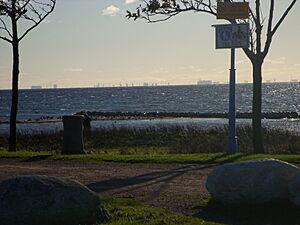
You can reach the island of Ven by taking a regular ferry. These ships usually depart 9 times a day. During July and August, there are even more services.
Landskrona's first railway station opened in 1863. It was close to the City Hall Square. In the 1920s, Landskrona station was the end point for three railway lines. These lines went to Eslöv, Kävlinge (with some trains continuing to Lund and Malmö), and to Billesholm. It's interesting that no railway was built to the nearby city of Helsingborg during this time.
The line to Billesholm closed before the 1960s. In the mid-1970s, the Swedish National Railways thought about closing all local train services in the south. But Landskrona and other towns helped create a new local railway system called Pågatåg. This new system, which started in 1983, was the first of its kind in Sweden outside of Stockholm.
When the Øresund Bridge was built, another train system called the Øresundståg was introduced. These are inter-regional and international trains that connect Denmark and Sweden by rail. For Landskrona, this meant a new station was needed. The old station only allowed trains to go south.
After discussions, it was decided to build a new high-speed railway between Helsingborg and Lund. This was part of a bigger plan for a West Coast Railway between Copenhagen and Gothenborg. Since Landskrona is between Helsingborg and Lund, it was included in the plans. The new railway just "touched" the eastern edge of the town, so a new station was built there.
The new Landskrona Station opened in January 2001. It allows for more train services than the old station. Today, all local Pågatågen trains and inter-regional Øresundståg trains stop at the new station. This means there are 4-6 trains per hour in each direction on weekdays.
A trolleybus shuttle service, called the "Station Shuttle", started in September 2003. It connects the new station with the city center and the ferry terminal in the harbor. This is the shortest trolleybus route currently operating in the world.
Thanks to the new train services, you can reach Copenhagen Airport in 50 minutes and central Copenhagen in 65 minutes. It's also possible to reach Copenhagen by taking a northbound train to Helsingborg. From there, you can take the HH ferry for a 20-minute sea trip to Helsingør. Then, you can take another train to Copenhagen. Even with two changes, you can usually reach the Danish Capital in less than 90 minutes.
Famous People from Landskrona
- King Erik VII of Pomerania
- Janet Ågren, Actress
- Olle Anderberg, Wrestler
- Andreas Augustsson, Swedish Footballer
- Ewa Aulin, Actress
- Ian Berry, British Artist (lived in Landskrona 2010-2015)
- The Bristles, Music band
- Tycho Brahe, Danish Astronomer
- Rudolf Cederström, Naval Commander
- Richard Dahl, High Jumper
- Frans Ekelund, City Architect from 1913–49
- Gabriella Fagundez, Swedish Swimmer
- Edvin Fältström, Wrestler
- Emil Fick, Fencer
- Emilush, Rapper and reggae artist
- Allvar Gullstrand, Eye doctor (Ophthalmologist)
- Charles X Gustav, King of Sweden
- Marcus Johansson (ice hockey, born 1990), Ice Hockey Player
- Martin Johansson (ice hockey, born 1987), Ice Hockey Player
- Sonny Johansson, Legendary Footballer for Landskrona BoIS
- Armand Krajnc, Boxing champion
- Selma Lagerlöf, Swedish Writer and Nobel Prize winner
- Oscar Ljung, Actor
- Max Lundgren, Swedish Children's Writer
- Siw Malmkvist, Swedish Singer
- Helmer Mörner, Equestrian (horse rider)
- Gustaf Nilsson (wrestler), Wrestler
- Rolf K. Nilsson, Member of Swedish Parliament (Riksdag)
- Jonas Olsson, Footballer
- Carl Fredrik Reuterswärd, Artist
- Amanda Röntgen-Maier, Violinist and composer
- Torsten Schmidt (officer), Military officer
- Mattias Sjögren, Swedish Ice Hockey Player
- Jesper Svenbro, Swedish Poet
- Svenska Akademien (musikgrupp), Reggae band
- Enoch Thulin, Swedish Aircraft Pioneer
- Torkild Strandberg, Swedish Politician
See also
 In Spanish: Landskrona para niños
In Spanish: Landskrona para niños



